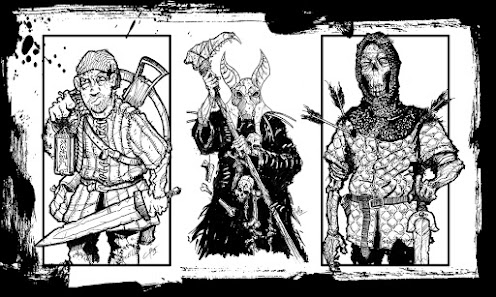This is the biggest challenge I’ve encountered while designing this ruleset. As there aren’t silver coins and shop merchants to get your gear from, you have to make it all yourself. Crafting is an easy mechanic if you’re playing a video game, not so much for a table top RPG. Roleplaying it out or having a bunch of dice rolls to see if you successfully chip a piece of flint isn’t very exhilerating, so my approach is simply going to be: you just do it. Although I have yet to play test any of this, these are my concepts.
Skill Sets: Each class will have a skill set for what they can craft: simple weapons, complex weapons, simple items, complex items, camp items, and totemic items.
Resources: The only resources that are tracked are food (meat and ruffage), herbs (for mixing poultices), and animal hides. Other resources like bone, wood or stone, are up the the GM. If you’re in the forest, there’s lots of wood and plant matter to work with, if you’re in the middle of the desert, it might be hard to find. Water does become a resource, but only if the environemt calls for it.
Herbalism: There won’t be any “mix one Herb A with two Herb B to make Poultice C.” Herbs will just be a general term, one poultice might take six Herbs to mix, another might take three. Although I may make an optional rule for people who really want to get into the weeds—pun sort of intended.
Crafting, Hunting and Gathering: Option 1
Time: Rather than rolling to see if you’re successful, you basically have a time frame to craft items. After a day of travelling, you might have five hours of “camp time” to hunt, forage, cook food and craft. Each item will have an entry something like:
Pack
Used to carry up to 6 normal size items to free up your hands, you can only carry one pack.
3 Hours | 2 Hides + Handaxe
If you have at least three hours, two hides and a handaxe, then you have successfully made a pack. No need to roleplay, no need to roll.
So simple a neanderthal could do it.
Because survival can be day to day, having to roleplay scenarios of hunting rabbits or gathering nuts and berries is unnecessary and slows things down. So, depending on the biome you’re in, hunting small game, gathering nuts, berries, and grubs, and foraging for herbs are each done with a single roll for each. Hunters get a bonus for hunting, and Gatherers a bonus for foraging. As above, you can make a test to hunt/forage for each hour that you attempt to do that task. The difficulty rating will depend on the biome you’re in. Hunting or foraging in a forest will have a low threshold for success, in a barren, dry desert, it will be much harder to find animals or viable plant life.
Forest Biome
Hunting DR10 | 2D6 Meat
Forage, Ruffage DR8 | 2D8 Ruffage
Forage, Herbs DR10 | 2D6 Herbs
Crafting, Hunting and Gathering: Option 2
To simplify the process even further (which might be a good thing), each player could have 2 “Camp Actions” to perform: cook, hunt, forage for food, forage for herbs, and/or craft a normal-sized item. Crafting would follow the rules the same as before in regard to resources, but ignore the time by replacing it with the Camp Actions. Each biome would have a die associated with an action, something like:
Forest Biome
Hunting D8
Forage, Ruffage D8
Forage, Herbs D8
Desert Biome
Hunting D4 – 2
Forage, Ruffage D4 –1
Forage, Herbs D4 – 2
Simply roll for each Camp Action that each player wants to peform, and that’s what you generate. Perhaps the hunter class would shift the die up by one for hunting—from D8 to D10, in the case of the forest, and the gatherer class would do the same for foraging.
Actions for crafting larger items, like a canoe or a hut, could take multiple actions beyond 2, that require help from multiple characters pitching in with the work.
Even simpler, a dim-witted neanderthal could do it.
Again, this all just my thoughts, as of yet to be tsted around the table. I am, of course, open to any thoughts the community might have. Has anyone played a game with crafting rules you thought were done really well? Leave a comment below by smashing your keyboard with a rock.
















